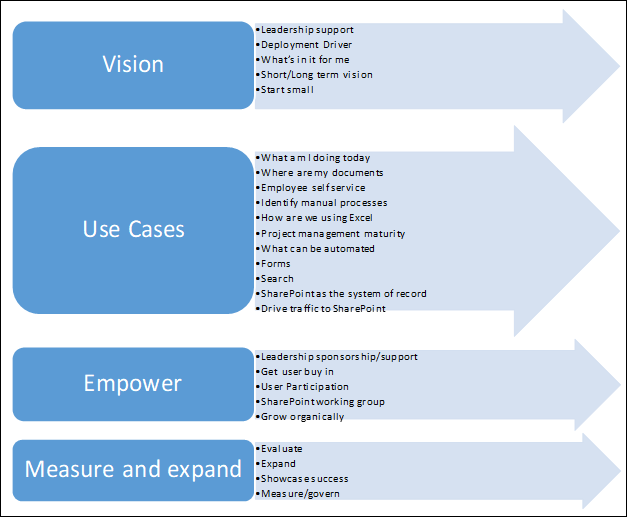SharePoint User Adoption
You have deployed SharePoint and now what. Here is a guide to gaining better user adoption within you're organization.
Share the vision
- Deployment driver - What got us here?
- Explain key business drivers and how it will impact them…for the better.
- Short/long term vision (phases of implementation and deployment)
- Start small and build momentum - don't build it in a day!
Identify relevant use cases
- What am I doing today?
- Don't focus on moving 50,000 documents to SharePoint…focus on what activities am I doing today or in the last week.
- This becomes you're immediate focus.
- SharePoint SME's work with these groups initially to help them identify/train/explain how SharePoint will truly make it easier for them.
- Where are people storing documents now?
- Start with the documents people use every day to collaborate.
- If they are emailing documents for review…create a document library to collaborate.
- Inventory the network drives to determine version history, folder security, nested folders (metadata).
- Employee self service
- ID what resources people most often request or call/E-mail about and then develop content around that.
- Site owners should constantly "mine" or review requests to keep the navigation current.
- What manual processes are done today?
- What activities can be automated with workflow?
- ID the inputs and desired state.
- How is Excel used?
- Is a list more conducive to a spreadsheet?
- Do users get locking messages all the time?
- Are there a lot of complex formulas? If not then consider a list.
- Contact lists or issue management stored in Excel and hard to manage?
- Project Management Maturity
- All the activities of project management fit nicely into SharePoint.
- Organize documents, tasks, issues, security etc in one site.
- Use search to create dashboards.
- Key processes that can be automated?
- Employee onboarding
- Services requests
- Any type of request and follow up process.
- What paper/electronic forms are being used that can become a list with a workflow?
- Internal documents used as a template users fill out and return.
- Paper forms that are printed and distributed.
- Non-controlled forms (tax forms for example)…NOT a good SharePoint solution.
- How are people finding information?
- Blanket E-mails…hey does anyone remember…or does any have the latest copy of XX.
- Navigating a folder structure.
- Using the search function in E-mail.
- Desktop search appliances?
- Give up and re-create?
- SharePoint becomes the system of record
- As information has been identified and migrated to SharePoint…leadership needs to communicate that SharePoint is where you will go for this.
- Remove permissions on file shares as content is migrated.
- Drive traffic to SharePoint
- Encourage attaching links in E-mails versus documents.
- Draft content on SharePoint and include links to the pages in E-mails or communications.
- Adopt this into the organizations culture…"it's on SharePoint"…"submit your XXX on SharePoint" … "I put the document on SharePoint so we can collaborate on it".
Empower people
- Leadership sponsorship and support
- Imperative to the success of any platform being adopted.
- Must be driven from the top down.
- Given the appropriate priority and resources to support.
- Get user buy in
- What's in it for them?
- Explain the use cases and practical ways it will impact their jobs/lives.
- Must be empathetic to their situations - can't be "another IT initiative"
- Users have to participate
- Identify those people that are technically more savvy and have usually been early adopters.
- Embrace technology and the change it brings and displays a positive attitude towards it.
- Provide them the necessary training to develop/enhance their skills.
- Try to engage people who know their department/business process and can adapt to the functionality in SharePoint to make a real impact in their area.
- Form a SharePoint working group
- Member include those business users identified above.
- Combination of training and how are you using it sessions.
- Promotes collaboration within the organization.
- Adoption will grow organically
- Once people see how it will benefit them they will either jump on or ignore it. Focus on those that jump on and want to be your champions.
- Have those champions work with the others in their department to foster/grow/train.
- SharePoint SME's continually work with users to refine/enhance how they are using SharePoint.
Measure the success and expand
- Evaluate what is working and adjust
- Keep content fresh and in front of people
- Continually monitor the information architecture for a better search/navigation experience.
- Identify what isn't working so well, analyze the outcome and make corrections.
- Expand to more groups
- Continue to execute on the long term strategy.
- Rinse and repeat on the approach.
- Showcase the successes
- During organization meetings, reference how SharePoint has transformed a department does business and why.
- Engage the communications people to help promote and use SharePoint. They generally send out the most customer facing information.
- Continually expand
- Start to identify more complex use cases and solutions.
- Review the information architecture for a relevant search experience.
- Measure and Govern
- Police the governance plan to identify trends and user actions.
- How many subsites are being created when a simple library can be used?
- Review user traffic to sites and start to trend it so you know how to structure the navigation to accommodate these habits.
- Review the 3 click rule (users shouldn't have to click more than 3 links to get where they need to) by analyzing usage patterns.
- Expand/modify governance where necessary to accommodate newly released features/functionality.
